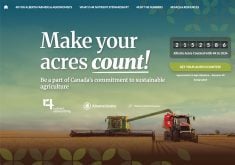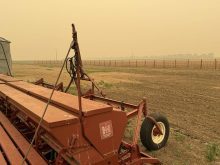Keeping the data straight for every field and crop might be optional for now, but traceability is the next reality
The world’s food system is slowly moving away from the bulk commodity model to one where stories on production techniques accompany products from farmgate to end users.
These emerging markets require traceability standards to help differentiate food or fuel in ways that a bulk commodity system for commodities like grain does not allow.
Two Canadian companies, Croptimistic Technology and Combyne Ag, are among those agricultural companies changing their business models to make this transition. They recently formed a new relationship.
A new feature on the Combyne online grain marketing system offers Swat Certified grain to grain buyers.
Read Also

Saskatchewan puts crown land auction on hold
Auctions of Saskatchewan crown lease land are once again on hold.
Swat Maps are management zone maps created with multiple layers of field data including soil, water, and topography that are derived from the electrical conductivity data collected by a device called Swat Box.
Soil tests are then taken in the various zones to find the nutrient needs within these zones to achieve target yields, which in turn are used to drive variable rate fertilizer application maps.
Cory Willness is the chief executive officer of Croptimistic Technology that builds the Swat Maps suite of products. He said the system enables growers to have a more efficient and environmentally friendly fertilizer program.
“Everybody that’s certifying the farmer are all partners that have signed agreements with us. So they’re all Swat Certified agronomy staff,” Willness said.
“These people are out there making recommendations and working with the farmers to apply their products more efficiently. That’s all recorded in our database, and it’s all confirmed that it was all completed by the staff that are out there. So that’s essentially how the certification is done.”
Swat Records is the software that runs the Swat ecosystem, which can be used to ensure fields are Swat Certified.
Willness said the Swat Certified designation on Combyne may just be the first step because there is more information that can be provided, including data from soil testing and even the variable rate prescriptions.
There are a few important metrics the program is missing that are important to a holistic understanding of a farm’s overall sustainability, including crop rotations and tillage practices.
However, nutrient management is increasingly under the microscope and the Swat Maps does show potential end users of the grain an indication that best management practices are being used when it comes to fertilizer.
This is especially the case with nitrogen, which when over-applied in saline areas, for instance, is prone to denitrification into nitrous oxide, a potent greenhouse gas.
Willness said there are an endless number of measurements that companies can use to gauge the environmental footprint of the ingredients in their supply chain, from wetland retention to carbon sequestration protocols, but many metrics are difficult to verify.
However, there are growers who already use practices that are more efficient than flat-rate fertilizer applications, and they should be recognized for it.
“You’re not going to say you’re limiting nitrous oxide emissions to the environment through nitrogen management if you’re not doing variable rate fertilizer. I can prove that, easy,” he said.
Willness said the company does not yet have any grain buyers lined up to use the Swat Certified program, but the relationship with Combyne is new and a buyer awareness program is about to be launched.
“We’re going to let buyers know what Swat Certified is, and try to attract new buyers that are looking for ingredients that may have some added value to them as part of its stewardship certification,” Willness said.
Some end users struggle to secure enough supply when sourcing grain with specific sustainability certifications.
There are about 1.5 million acres currently managed with Swat Maps, which may entice food companies to investigate whether the Swat Certification is something compatible with their sustainability goals.
Combyne is a grain marketing hub that helps farmers describe their inventory and its CEO, Alain Goubau, said the information Swat Maps can provide is a good fit with the hub.
Users of Combyne enter “the commodity, the quantity, the quality, but also if there’s a story associated with how they grew it, we also want to get them the options that pull that information,” Goubau said.
He said the relationship with Swat Maps helps to lay the foundation toward a future where stewardship-related indicators or information will become part of grain marketing opportunities for users of Combyne.
“There are a few companies working on building this digital infrastructure downstream from the farm and into these various grain and oilseed end-use cases. We also view them as collaboration partners for Combyne Connect,” Goubau said.
He said it will take time before farmers see potential premiums or privileged market access based on end user requirements.
“At this point, this infrastructure build up is largely nascent and being developed through pilots, but it is important to start experimenting by participating in early versions of these now,” Goubau said.
















